Can anyone really justify the awesome power of a Mercedes
Page 37
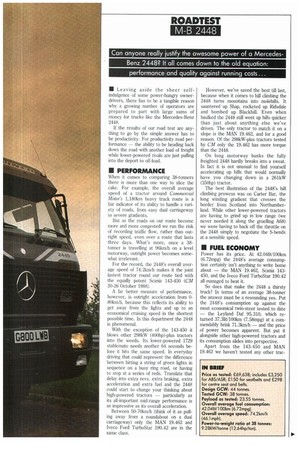
Page 38
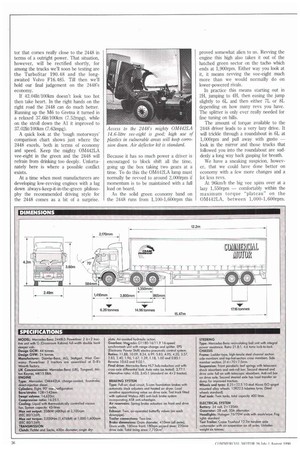
Page 39
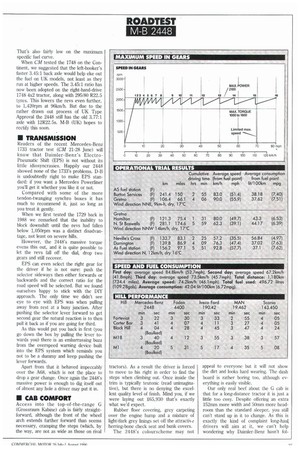
Page 40
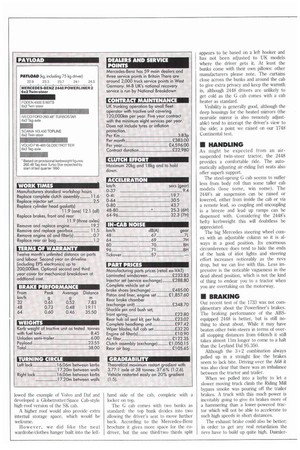
Page 41
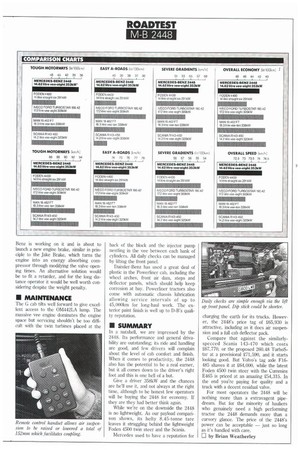
If you've noticed an error in this article please click here to report it so we can fix it.
Benz 2448? It all comes down to the old equation: performance and quality against running costs ...
• Leaving aside the sheer selfindulgence of some power-hungry ownerdrivers, there has to be a tangible reason why a growing number of operators are prepared to part with large sums of money for trucks like the Mercedes-Benz 2448.
If the results of our road test are anything to go by the simple answer has to be productivity. For productivity read performance — the ability to be heading back down the road with another load of freight while lower-powered rivals are just pulling into the deport to off-load.
• PERFORMANCE
When it comes to comparing 38-tonners there is more than one way to slice the cake. For example, the overall average speed of a tractor around Commercial Motor's 1,180km heavy truck route is a fair indicator of its ability to handle a variety of roads, from easy dual carriageway to severe gradients.
But as the roads on our route become more and more congested we run the risk of recording traffic flow, rather than outright speed, even over a route that lasts three days. What's more, once a 38tanner is travelling at 96km/h on a level motorway, outright power becomes somewhat irrelevant.
For the record, the 2448's overall average speed of 74,2km/h makes it the joint fastest tractor round our route tied with the equally potent Scania 143-450 (CM 20-26 October 1988).
A far better measure of performance, however, is outright acceleration from 080km/h, because this reflects its ability to get away from the lights and up to an economical cruising speed in the shortest possible time. In this department the 2448 is phenomenal.
With the exception of the 143-450 it blows other 298kW (400hp)-plus tractors into the weeds. Its lower-powered 1729 stablemate needs another 64 seconds before it hits the same speed. In everyday driving that could represent the difference between hitting a string of green lights in sequence on a busy ring road, or having to stop at a series of reds. Translate that delay into extra revs, extra braking, extra acceleration and extra fuel and the 2448 could start to change your thinking about high-powered tractors — particularly as its all-important mid-range performance is as impressive as its overall acceleration.
Between 50-70km/h (think of it as pulling away from a roundabout on a dual carriageway) only the MAN 19.462 and Iveco Ford TurboStar 190.42 are in the same class.
However, we've saved the best till last, because when it comes to hill climbing the 2448 turns mountains into molehills. It sauntered up Shap, rocketed up Ridsdale and bombed up Blackhill. Even when baulked the 2448 still went up hills quicker than just about anything else we've driven. The only tractor to match it on a slope is the MAN 19.462, and for a good reason. Of the 298kW-plus tractors tested by CM only the 19.462 has more torque than the 2448.
On long motorway banks the fully freighted 2448 hardly breaks into a sweat. In fact it is not unusual to find yourself accelerating up hills that would normally have you changing down in a 261kW (350hp) tractor.
The best illustration of the 2448's hill climbing prowess was on Carter Bar, the long winding gradient that crosses the border from Scotland into Northumberland. While other lower-powered tractors are having to grind up in low range (we never needed it along the gruelling A68) we were having to back off the throttle on the 2448 simply to negotiate the S-bends at a sensible speed.
• FUEL ECONOMY
Power has its price. At 42.041it/100km (6.72mpg) the 2448's average consumption certainly isn't anything to write home about — the MAN 19.462, Scania 143450, and the Iveco Ford TurboStar 190.42 all managed to beat it.
So does that make the 2448 a thirsty truck? In terms of an average 38-tonner the answer must be a resounding yes. Put the 2448's consumption up against the most economical twin-steer tested to date — the Leyland Daf 95.310, which returned 37.31it/100km (7.58mpg) at a commendably brisk 71.3km/h — and the price of power becomes apparent. But put it alongside other high-powered tractors and its consumption slides into perspective.
Apart from the 143-450 and MAN 19.462 we haven't tested any other trac tor that comes really close to the 2448 in terms of a outright power.. That situation, however, will be rectified shortly, for among the trucks we'll soon be testing are the TurboStar 190.48 and the longawaited Volvo F16.485. Till then we'll hold our final judgement on the 2448's economy.
If 42.04k/100km doesn't look too hot then take heart. In the right hands on the right road the 2448 can do much better. Running up the M6 to Gretna it turned in a relaxed 37.6lit/100km (7.52mpg), while on the stroll down the Al it improved to 37.02lit/100krn (7.63mpg).
A quick look at the 'tough motorways' comparison chart shows just where the 2448 excels, both in terms of economy and speed. Keep the mighty 0M442LA vee-eight in the green and the 2448 will refrain from drinking too deeply. Unfortunately here is where a possible conflict -exists.
At a time when most manufacturers are developing low-revving engines with a lug down always-keep-it-in-the-green philosophy the recommended driving style for the 2448 comes as a bit of a surprise. Because it has so much power a driver is encouraged to block shift all the time, going up the box taking two gears at a time. To do this the 0M442LA lump must normally be revved to around 2,000rpm if momentum is to be maintained with a full load on board.
As the solid green economy band on the 2448 runs from 1,100-1,600rpm this proved somewhat alien to us. Revving the engine this high also takes it out of the hatched green sector on the tacho which ends at 1,900rpm. Either way you look at it, it means revving the vee-eight much more than we would normally do on lower-powered rivals.
In practice this means starting out in 2H, jumping to 4H, then easing the jump slightly to 6L and then either 7L or 8L depending on how many revs you have. The splitter is only ever really needed for fine tuning on hills.
The amount of torque available to the 2448 driver leads to a very lazy drive. It will trickle through a roundabout in 6L at 1,000rpm and pull away with gusto — look in the mirror and those trucks that followed you into the roundabout are suddenly a long way back gasping for breath.
We have a sneaking suspicion, however, that we could have done better on economy with a few more changes and a lot less revs.
At 96km/h the big vee spins over at a lazy 1,550rpin — comfortably within the maximum torque "plateau" on the 0M442LA, between 1,000-1,600rpm. That's also fairly low on the maximum specific fuel curve.
When CM tested the 1748 on the Continent, we suggested that the left-hooker's faster 3.45:1 back axle would help eke out the fuel on UK models, not least as they run at higher speeds. The 3.45:1 ratio has now been adopted on the right-hand-drive 1748 4x2 tractor, along with 295/80 R22.5 tyres. This lowers the revs even further, to 1,420rpm at 96km/h. But due to the rather drawn out process of UK Type Approval the 2448 still has the old 3.77:1 axle with 12R22.5s. M-B (UK) hopes to rectify this soon.
• TRANSMISSION
Readers of the recent Mercedes-Benz 1733 tractor test (CM 21-28 June) will know that Daimler-Benz's ElectroPneumatic Shift (EPS) is not without its little idiosyncrasies. Happily our 2448 showed none of the 1733's problems. D-B is undoubtedly right to make EPS standard: if you want a Mercedes Powerliner you'll get it whether you like it or not.
Compared with some of the more tendon-twanging synchro boxes it has much to recommend it, just so long as you treat it gently.
When we first tested the 1729 back in 1988 we remarked that the inability to block downshift until the revs had fallen below 1,050rpm was a distinct disadvantage, not least on severe hills.
However, the 2448's massive torque evens this out, and it is quite possible to let the revs fall off the dial, drop two gears and still recover.
EPS can even select the right gear for the driver if he is not sure: push the selector sideways then either forwards or backwards and the correct ratio for the road speed will be selected. But we found ourselves happy to stick with the DIY approach. The only time we didn't see eye to eye with EPS was when pulling away from rest at a busy junction. After pushing the selector lever forward to get second gear the natural reaction is to then pull it back as if you are going for third.
As this would put you back in first (you go down the box by pulling the lever towards you) there is an embarrassing buzz from the overspeed warning device built into the EPS system which reminds you not to be a dummy and keep pushing the lever forwards.
Apart from that it behaved impeccably over the A68, which is not the place to drop a gear change. Once again the 2448's massive power is enough to dig+ itself out of almost any hole a driver may put it in.
• CAB COMFORT
Access into the top-of-the-range G (Grossraum Kabine) cab is fairly straightforward, although the front of the wheel arch extends further forward than seems necessary, cramping the steps (which, by the way, are not as wide as those on rival tractors). As a result the driver is forced to move to his right in order to find the steps when climbing out. Once inside the trim is typically teutonic (read unimaginative), but there is no denying the excellent quality level of finish. Mind you, if we were laying out £65,930 that's exactly what we'd expect.
Rubber floor covering, grey carpeting over the engine hump and a mixture of light/dark grey linings set off the attractir‘t herring-bone check seat and bunk covers.
The 2448's colourscheme may not appeal to everyone but it will not show the dirt and looks hard wearing. The dash board is rather boring too, although everything is easily visible.
Our only real beef about the G cab is that for a long-distance tractor it is just a little too cosy. Despite offering an extra 152mm more width and 50mm more headroom than the standard sleeper, you still can't stand up in it to change. As this is exactly the kind of complaint long-haul drivers will aim at it, we can't help wondering why Daimler-Benz hasn't fol
lowed the example of Volvo and Daf and developed a Globetrotter/Space Cab-style high-roof version of the SK cab.
A higher roof would also provide extra internal storage space, which would be welcome.
However, we did like the neat wardrobe/clothes hanger built into the left hand side of the cab, complete with a locker on top.
The G cab comes with two bunks as standard: the top bunk divides into two allowing the driver's seat to move further back. According to the Mercedes-Benz brochure it gives more space for the codriver, but the one third/two thirds split appears to be based on a left hooker and has not been adjusted to UK models where the driver gets it. At least the bunks come with their own pillows: other manufacturers please note. The curtains close across the bunks and around the cab to give extra privacy and keep the warmth in, although 2448 drivers are unlikely to get cold as the G cab comes with a cab heater as standard.
Visibility is generally good, although the deep housings for the heated mirrors (the nearside mirror is also remotely adjustable) tend to interupt the driver's view to the side; a point we raised on our 1748 Continental test.
• HANDLING
As might be expected from an airsuspended twin-steer tractor, the 2448 provides a comfortable ride. The automatically adjusting air-riding Isri seats also offer superb support.
The steel-sprung G cab seems to suffer less from body roll than some taller cab models (lose some, win some). The 2448's air suspension can be raised or lowered, either from inside the cab or via a remote lead, so coupling and uncoupling is a breeze and lead up ramps can be dispensed with. Considering the 2448's hefty kerbweight this will doubtless be appreciated.
The big Mercedes steering wheel comes with an adjustable column so it is always in a good position. Its enormous circumference does tend to hide the ends of the bank of idiot lights and steering effort increases noticeably as the revs drop, but we can live with this. Less impressive is the noticable vagueness in the dead ahead position, which is not the kind of thing to endear you to a tractor when YOU are overtaking on the motorway.
• BRAKING
Our recent test of the 1733 was not complimentary about the Powerliner's brakes. 'lie braking performance of the ABSequipped 2448 is better, but is still nothing to shout about. While it may have beaten other twin-steers in terms of overall stopping distances from 64km/h it still takes almost llm longer to come to a halt than the Leyland Daf 95.350.
Although the 3+2 combination always pulled up in a straight line the brakes seem to lack bite. Driving over the A68 it was also clear that there was an imbalance between the tractor and trailer.
When we pulled into a layby to let a slower moving truck climb the Riding Mill bypass smoke was pouring off the trailer brakes. A truck with this much power is inevitably going to give its brakes more of a hammering than a lower-powered tractor which will not be able to accelerate to such high speeds in short distances.
The exhaust brake could also be better; in order to get any real retardation the revs have to build up quite high. Daimler Benz is working on it and is about to launch a new engine brake, similar in principle to the Jake Brake, which turns the engine into an energy absorbing compressor through modifying the valve opening times. An alternative solution would be to fit a retarder, and for the long distance operator it would be well worth considering despite the weight penalty.
• MAINTENANCE
The G cab tilts well lorward to give excellent access to the 0M442LA lump. The massive vee engine dominates the engine space but servicing shouldn't be too difficult with the twin turbines placed at the back of the block and the injector pump nestling in the vee between each bank of cylinders. All daily checks can be managed by lifting the front panel.
Daimler-Benz has used a great deal of plastic in the Powerliner cab, including the wheel arches, front air dam, steps and deflector panels, which should help keep corrosion at bay. Powerliner tractors also come with automatic chassis lubrication allowing service intervals of up to 45,000km for long-haul work. The exterior paint finish is well up to D-B's quality reputation.
• SUMMARY
In a nutshell, we are impressed by the 2448. Its performance and general drivability are outstanding; its ride and handling are good, and few drivers will complain about the level of cab comfort and finish. When it comes to productivity, the 2448 also has the potential to be a real earner, but it. all comes down to the driver's right foot and this is one hell of a but.
Give a driver 358kW and the chances are he'll use it, and not always at the right time, although to be honest few operators will be buying the 2448 for economy. If they are they had better think again.
While we're on the downside the 2448 is no lightweight. As our payload comparison shows, its hefty 8.45-tonne tare leaves it struggling behind the lightweight Foden 4500 twin steer and the Scania.
Mercedes used to have a reputation for charging the earth for its trucks. However, the 2448's price tag of £65,930 is attractive, including as it does air suspension and a full cab deflector pack.
Compare that against the similarlyspecced Scania 143-470 which costs £67,770, or the proposed 260.48 TurboStar at a provisional £71,590, and it starts looking good. But Volvo's tag axle F16485 shaves it at £64,000, while the latest Foden 4500 twin steer with the Cummins E465 is priced at an amazing £54,315. In the end you're paying for quality and a truck with a decent residual valve.
For most operators the 2448 will be nothing more than a extravagent pipedream. But for the minority of hauliers who genuinely need a high performing tractor the 2448 demands more than a cursory glance. The price of the 2448's power can be acceptable just so long as it's handled with care.
ID by Brian Weatherley
















































































































